
By Brad Barr, Expedition Coordinator, NOAA Office of National Marine Sanctuaries Maritime Heritage Program
Summary: After nearly two decades of searching, NOAA Ocean Exploration, the NOAA Office of National Marine Sanctuaries' Maritime Heritage Program, the U.S. Coast Guard, and a number of academic research partners have located with "reasonable certainty" the final resting place of U.S. Revenue Cutter Bear, 90 miles due south of Cape Sable, Nova Scotia. Having served for nearly 80 years, including in the U.S. Revenue Cutter Service, the U.S. Navy, and as a ship of exploration in the Antarctic, Bear is considered one of the most historically significant ships in U.S. history for its long and meritorious service.
In this essay: Expeditions Overview | Historical Context | Identifying the Wreck | Diagnostic Evidence | Concluding Remarks
Since the late 1970s, various researchers have been searching for the final resting place of the storied U.S. Revenue Cutter (USRC) Bear (see Search for the Bear, 1979-2019). Building on this work and conducting extensive background research on the ship and its long history, the U.S. Coast Guard (USCG), NOAA Office of National Marine Sanctuaries’ Maritime Heritage Program, and NOAA Ocean Exploration forged a partnership to continue the search employing advanced underwater technology.
In 2019, working off the USCG’s medium-endurance cutter Bear (named for U.S. Revenue Cutter Bear), 62 square miles of seabed was mapped, and two targets for further exploration were found. One target in particular was very promising as it was in the proximity of the last known position where Bear was lost at sea in 1973, and it appeared to roughly match the dimensions of the ship (see Mission Summary).
In 2021, USCG and NOAA researchers went back to sea on the USCG’s ocean-going buoy tender Sycamore (see Expedition Summary), this time with an advanced remotely operated vehicle (ROV) equipped with high-resolution underwater video cameras and skilled and experienced operators from Marine Imaging Technologies to document the “unidentified wreck” found in 2019. While the operational conditions encountered at the site were challenging (See: Holding Position), the team was able to collect video and still images sufficient to provide the documentation needed to identify the wreck.
A team of experienced historians and archaeologists from the partner agencies was empaneled to review this data and information and came to consensus that they are “reasonably certain” that the “unidentified wreck” is indeed U.S. Revenue Cutter Bear.
What follows is a brief history of USRC Bear and its many achievements. Links to posted background documents on specific events and highlights are included to offer more detailed information.
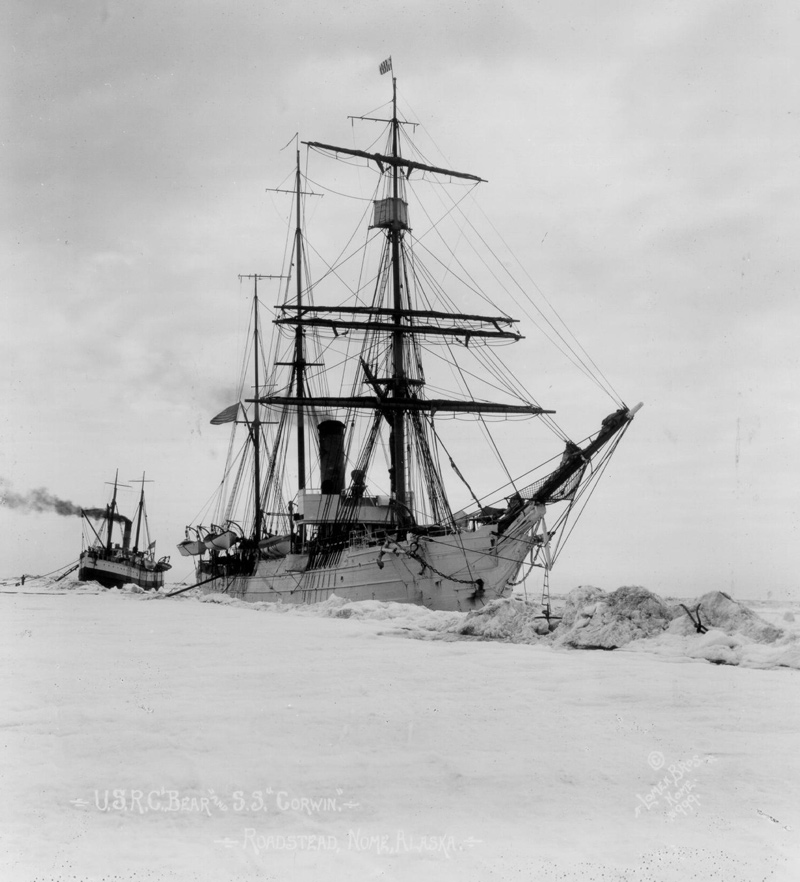
U.S. Revenue Cutter Bear leading SS Corwin (an ex-U.S. Revenue Cutter) into Nome Roadstead, 1915. Image courtesy of the U.S. Coast Guard. Download image (jpg, 203 kb).

Sinking of the U.S. Revenue Cutter Bear, dated March 19, 1963. Image from USCG History Program fact sheet, “Bear, 1885.” Download image (jpg, 50 kb).
In the entire maritime history of the United States, few ships have been so routinely identified as “iconic” and “legendary,” and none more historically significant than U.S. Revenue Cutter Bear. Largely associated with polar exploration, and particularly its Arctic service, the ship’s history is a series of compelling stories of bravery in the face of peril, dedication to duty, and legendary exploits.
Built in Scotland originally as a sealer in 1874, for the first 10 years of service, Bear operated as part of the commercial sealing fleet off Newfoundland. Purchased by the U.S. Government, she was put into service by the U.S. Navy as part of the rescue fleet for the Greely Expedition to the Arctic in 1884, and first came to world-wide acclaim as the vessel that rescued the few survivors of that disastrous expedition. In 1885, Bear was transferred from the Treasury Department for service in the Arctic as a Revenue Cutter, and for an unprecedented 41 years, ably patrolled the Arctic, saving lives and dispensing justice in this remote and often challenging region.
Between 1886-1895, Bear’s captain was the legendary "Hell Roaring” Mike Healy. While he never, during his lifetime, self-identified as African American, perhaps to avoid the prejudice he would likely have encountered in in personal life and career, he was in reality the first person of African American descent to command a ship of the U.S. Government. The U.S. Coast Guard Cutter Healy, commissioned in 1999 and routinely operating in Alaska, was named in his honor.
Also notable was the so-called “Overland Rescue of 1897.” Discovering that eight whaling ships were trapped in the ice off Barrow, a small team was dispatched from Bear, lead by LT David Jarvis and accompanied by LT Ellsworth Berthoff and ship’s surgeon Dr. Samuel Call, from Nelson Island near the Bering Strait to drive a herd of 450 reindeer 1,600 miles, in the driving snow and perilous conditions of the Arctic winter, to Barrow to provide food to the 275 men from the whaling ships stranded onshore. To this day, the U.S. Coast Guard’s highest honor for bravery is named for the leader of that expedition, Lt. David Jarvis.
Bear remained in meritorious service in the Arctic until 1917, when she was transferred back to the U.S. Navy during World War I. After the war, Bear returned to again patrol Arctic waters. Notable during this second patrol was the ship’s support of relief operations in the region during the Spanish Flu Epidemic of 1919.
The ship was decommissioned by the U.S. Government in 1929 and given to the City of Oakland, California, where she was repurposed as a maritime museum and used as the movie set for the 1930 film of Jack London’s The Sea Wolf. However, the ship was not long idle, as Admiral Richard Byrd purchased the still stout ship for his second Antarctic expedition (See: Bear and the Byrd Expeditions to Antarctica). She was refit and performed admirably for both this successful expedition, in 1933-1935, and later for the U.S. Antarctic Expedition of 1939-1941. During World War II, Bear again went into service for the U.S. Navy in the Greenland Patrol and notably participated in the capture of a German spy vessel, the trawler Buskoe.
Ending her service as a commissioned vessel in 1944, Bear was sold in 1948 to a Canadian steamship company to be re-converted to her original purpose as a sealer, but poor market conditions caused the company to abandon her on a wharf in Nova Scotia. The ship was saved from this fate by an entrepreneur from Pennsylvania, who purchased Bear in the early 1960s to become a museum and restaurant on the waterfront in Philadelphia, Pennsylvania. Unfortunately, the ship was lost while being towed to her new berth in 1963, and her final resting place lies, according to the position recorded at the time of the sinking, somewhere around 260 miles off Boston, approximately 90 miles South of Cape Sable, Nova Scotia.
In August of 2021, a group of maritime archaeologists and historians was assembled, representing the partner agencies (NOAA and USCG), selected for their considerable relevant knowledge and expertise in conducting such wreck identifications. This “evaluation team” was provided with this mission summary and findings presented here (but more extensively documented in that summary findings document), copies of the two sets of plans obtained from Mystic Seaport and the USCG Archives, as well as a selection of still images and more than an hour of video from the ROV documentation survey.
Based on their detailed individual reviews of these data and information, a consensus was reached that the team was collectively “reasonably certain” that the “unidentified wreck” was U.S. Revenue Cutter Bear. Clearly, had something with the name “Bear” inscribed on it been observed, if the transom was still intact and the name “Bear” was displayed, or some other irrefutable evidence identified, this task would have been considerably easier.
Unfortunately, this was not the outcome of the survey, as is generally the case with determining the identity of a wreck having been so extensively damaged by human activity. The “unidentified wreck” was degraded by mobile fishing gear as well as by the ravages of time, so reaching some absolutely definitive finding of its identity was therefore unrealistic.
However, particular evidence presented was compelling nonetheless. During the documentation of the wreck and its surrounding area, certain diagnostic features were identified, based on available historic photographs, construction plans of Bear (obtained from Mystic Seaport and the USCG Historian’s Office), and other published sources of information. While there were no absolutely “definitive” features identified, such as an artifact inscribed with the name of the vessel, nor was the hull intact enough to find the name of the vessel on the transom or other part of the wreck, certain features documented may be sufficiently similar to the structure and configuration of Bear to suggest its identification as this vessel.
Bear was refit and modified a number of times over its period of service for various tasks. Unfortunately, little information is available regarding these modifications, which include, for example, the removal of the steam engine and its replacement with a diesel engine (1939) and ultimately the removal of that engine and drive train components when Bear was decommissioned in 1944, as well as structural modifications to the engine room. The construction plans present Bear as it was when it was built in 1874 (Mystic Seaport plans) and in 1897 (USCG/Smithsonian plans). Therefore, some of what is observed in the ROV imagery could not be identified in these plans. However, while some of Bear’s features may have changed over its 89 years of service, it is presumed that the basic structure of the vessel, and many of the original features, remained unmodified.
The consideration of “diagnostic features,” in this application, also include elements or parts of the vessel known to have been removed before its loss, including the engine, drive train, and ballast. As a part of the ROV documentation, particular attention was directed at looking for these items in the places where they would have been located if not removed.
Bear possessed a unique forefoot and bow construction, specifically focused on protection from ice through which the vessel was designed to travel. Figure 1 provides the 1897 construction plan for this part of the ship.
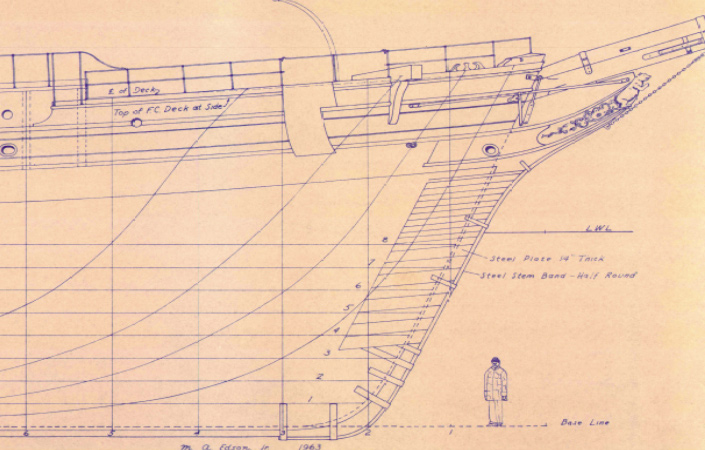
Figure 1: Bow section of U.S. Revenue Cutter Bear from 1897 construction plans. Redrawn in 1963 by the Smithsonian Division of Naval History. Download image (jpg, 271 kb).
Of interest are three particular elements identified in the plan: the one-quarter-inch steel plate, the half-round steel stem band, and the steel “staples” (rectangular elements that are situated perpendicular to the stem) that hold the stem band in place. Both sets of plans show these features.
Figure 2 is a photograph, c. 1924-5, taken after Bear was grounded in 1924 and required repair. The steel plate, half-round stem band, and steel “staples” are all present in this historic photograph.
These same features were observed during the 2021 ROV survey of the wreck (Figure 3). Particular attention should be directed at the size and spacing of the staples seen in the image. Unlike the depiction of this feature in the drawing provided in Figure 1, where the staples are somewhat uniformly spaced and perhaps of similar widths, both the photograph and the ROV imagery show the top two staples are thinner and closer together and the next two staples below them are also closer together and wider than the ones above. The bottom staple is farther away from the other four, is intermediate in length between the top two and the two just below, but is about the same width as the two just above. While not as clearly depicted in Figure 3, the half-round stem band is also present, being affixed to the stem with the staples.
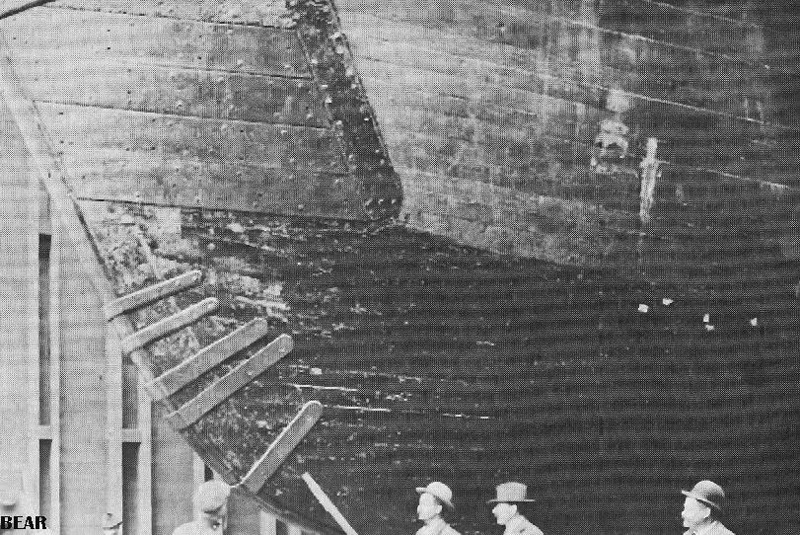
Figure 2: Forefoot of U.S. Revenue Cutter Bear under repair (c. 1924-1925). Image courtesy of the U.S. Coast Guard. Download image (jpg, 140 kb).
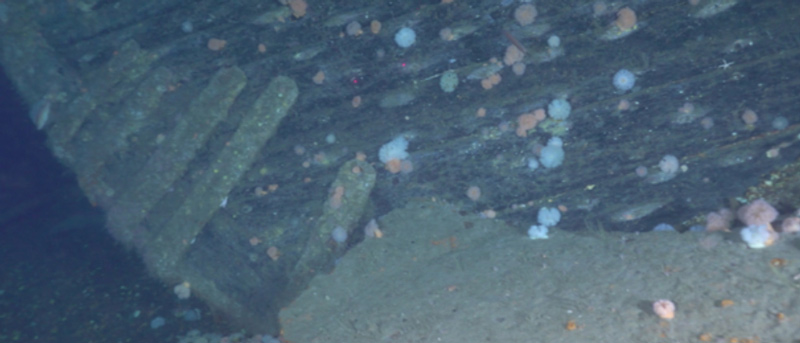
Figure 3: Remotely operated vehicle image of the “unidentified wreck” collected in 2021 showing similar spacing and size of bow staples to those seen in the 1924 image of U.S. Revenue Cutter Bear (Figure 2). Image courtesy of NOAA/MITech. Download image (jpg, 202 kb).
Extensively encrusted with organisms (largely anemones and sponges), the steel sheeting is also present in the historic photo and the ROV images. While not shown, in this area of the bow on the opposite (starboard) side, which is similarly encrusted, the staples are not as evident.
Figure 4 highlights the similarities between the steel sheathing observed in the ROV images and their configuration during a drydock repair for Bear in 1924-25, offering additional compelling evidence as to the identity of the wreck.
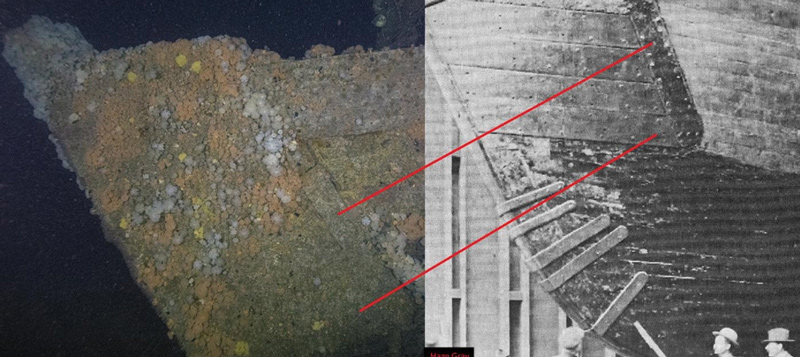
Figure 4: Port bow of the “unidentified wreck” imaged in 2021 on the left showing similar sheathing patterns to the historic image of U.S. Revenue Cutter Bear while in dry dock in 1925. Left image courtesy of NOAA/MITech; right image courtesy of the U.S. Coast Guard. Download image (jpg, 429 kb).
The details of the construction of Bear’s bow and sheathing of the entire length of the vessel from the keel to the waterline are documented in a number of sources, including Burroughs (1970), Bixby (1965), and Wead (1937). Of particular note was the multiple layers of sheathing in this lower part of the hull, with two underlayers of oak, the outer layer being Australian Ironbark, all approximately (and variously reported as) six to eight inches thick and fastened with Swedish iron bolts. The ribs were also of English oak, 14-inch square, spaced 5 to 6 inches apart in the bow (Robinson, 1953). In his first-person narrative about his service on Bear during the Byrd Antarctic Expeditions, engineer Russell S. Robinson provides a hand drawing of this arrangement (Figure 5).
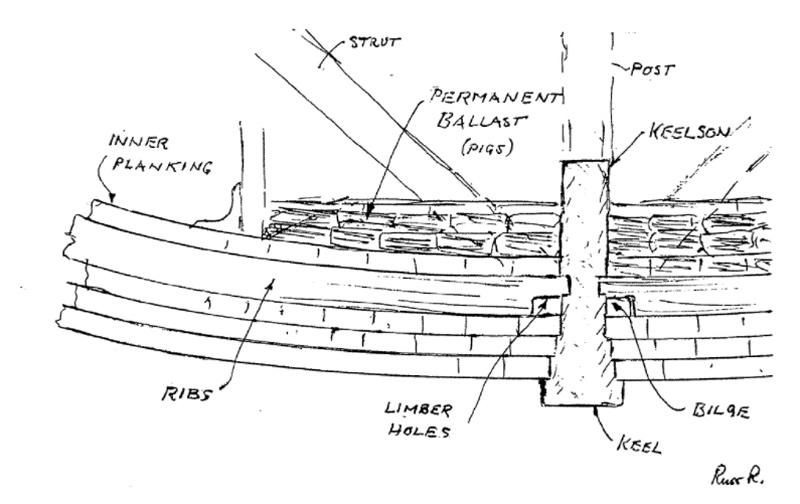
Figure 5: Arrangement of the U.S. Revenue Cutter Bear’s hull sheathing, as illustrated by engineer Russell S. Robinson. Image courtesy of Robinson (1953). Download image (jpg, 165 kb).
It is not clear from the various available sources whether the stout six to eight-inch thick planks that sheathed the hull below the waterline continued further up in the bow, but there was mention of multiple layers of sheathing in the bow section in these sources.
Because the wreck was oriented upright, the waterline to the keel section of the hull was buried in the seabed. However, as regards the bow, which was relatively intact, there were multiple layers of sheathing observed (Figure 6). For scale, the lasers on the ROV were 7.5 inches apart.
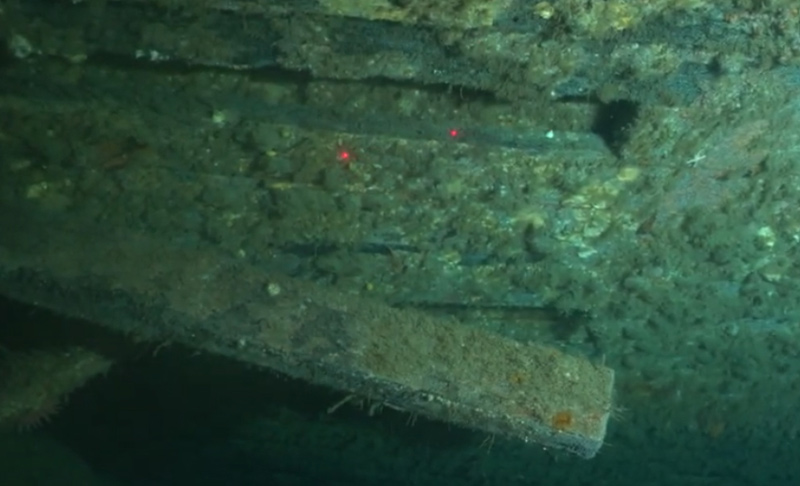
Figure 6: Multiple layers of sheathing in the port bow section of the shipwreck explored in 2021. Image courtesy of NOAA/MITech. Download image (jpg, 210 kb).
While these planks in the bow, around the curve of the hull on the port side, appear to be less than six inches thick, they are nonetheless applied in multiple layers, and are around seven inches wide. Clearly, however, this vessel is stoutly built, as would be expected for a vessel that was constructed for polar service.
An interesting structure was observed located a few meters beyond the extent of the wreckage at the site (Figure 7). Constructed of some type of cast metal, this piece of the wreckage contains a circular tube at one end, appearing to be about the same diameter as the drive shaft specifications provided in the Bear plans. Given its location, just past where the stern of the ship would have been, it is suggested that this may be part of the drive train of the vessel, perhaps a stern tube.
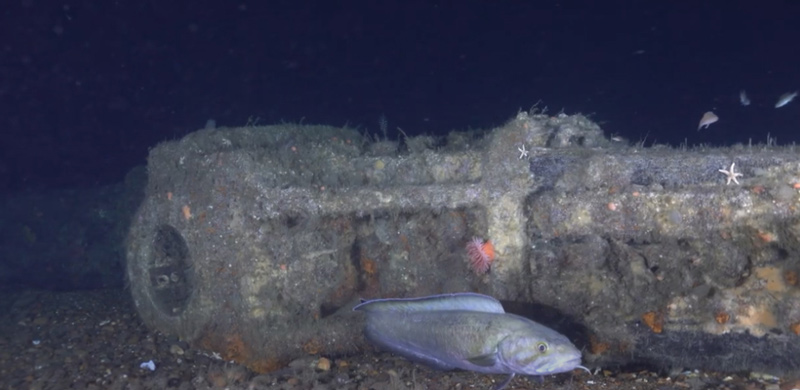
Figure 7: Possible stern tube of the shipwreck explored in 2021. Image courtesy of NOAA/MITech. Download image (jpg, 259 kb).
This structure may be most appropriately described as a “propeller post,” defined as “the forward post of a stern frame on vessels having a center line propeller. It provides a support for the stern tube and propeller shaft as well as joining frame for the converging sides of the ship at the stern” Webster (1920). In Figure 7, note the areas above and forward of the fish, which appear to contain large bolt heads in a somewhat discernable pattern, as well as what is presumed to be the stern tube, on the left.
In September of 1933, in preparation for Byrd’s expeditions to the Antarctic, Bear of Oakland was in drydock in Boston to be repaired and refit, including the installation of a diesel engine and new propeller, among many other improvements. Figure 8 shows the ship in drydock at the East Boston Shipyard. Notice in this photograph, there are workmen shown installing a new propeller.
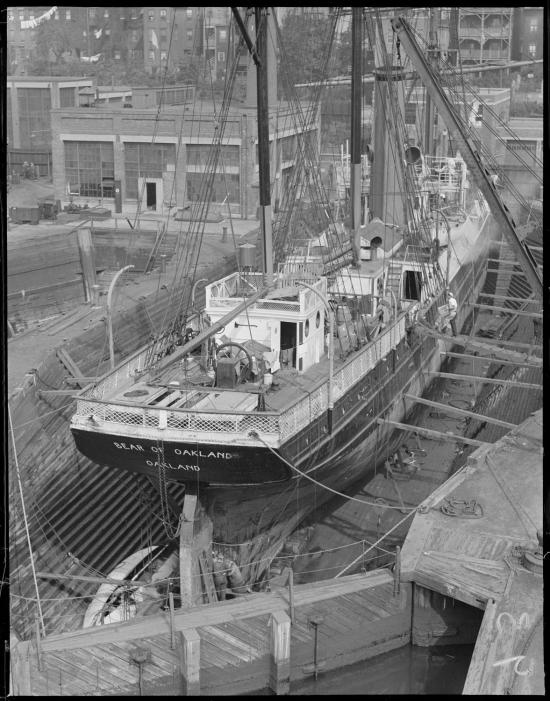
Figure 8: Bear of Oakland in drydock, East Boston Shipyard, 1933. Image courtesy of the Boston Public Library, Leslie Jones Collection. Download image (jpg, 79 kb).
Figure 9 provides a closer look at the workmen installing the new propeller, standing just behind the propeller post, highlighted in the red box. The bolt heads can be seen quite clearly in this photograph.
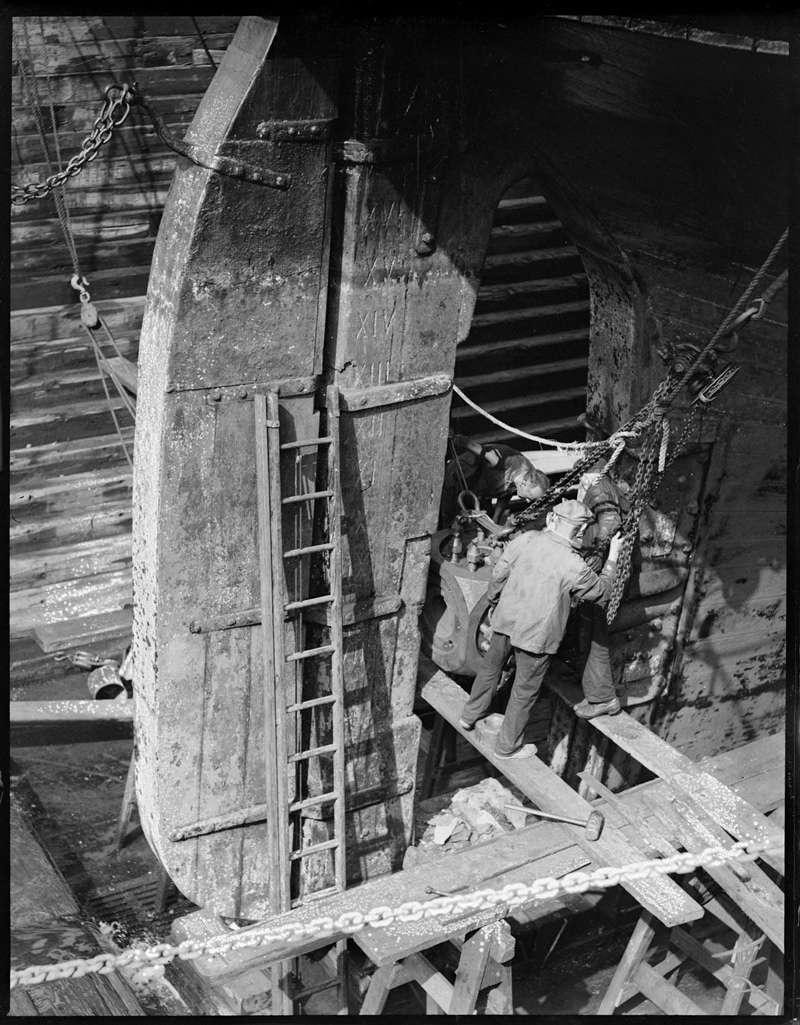
Figure 9: Location and detail of the propeller post on Bear of Oakland, 1933. Image courtesy of the Boston Public Library, Leslie Jones Collection. Download image (jpg, 328 kb).
Figure 10 is a close up of Figure 9 and the structure identified in the ROV survey, highlighting and comparing the bolt patterns and raised feature that are cast into the structure.
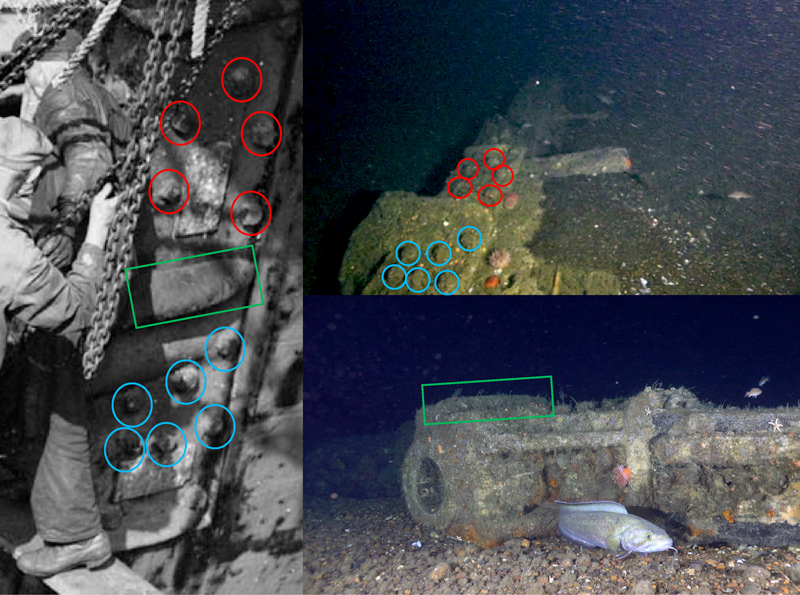
Figure 10: Comparison of bolt patterns from 1933 photograph (left) and structure observed in the 2021 remotely operated vehicle survey of the shipwreck. Left image courtesy of the Boston Public Library, Leslie Jones Collection; right images courtesy of NOAA/MITech. Download image (jpg, 1.3 MB).
These bolt patterns appear to be quite similar and are considered an important diagnostic feature, further supporting the identification of this wreck as Bear.
Many other features identified in the ROV documentation were considered by the evaluation team as supporting, but somewhat less definitive, in identifying the wreck as Bear, including:
Two important elements of many wrecks which are almost always observed and usually persistent over time, unlike wood, are engines and, perhaps somewhat less often, ballast.
Engine
Throughout the ROV survey of the wreckage, particular attention was directed at finding an engine, or what might remain of one. There is, in what would be the midship’s area (see Figure 11), what has been initially identified as an engine compartment. No evidence of an engine or other drive train components is seen in this location, or anywhere on the wreck.
The ship’s logbook entry for October 9, 1939, before the Antarctic voyages, mentions installing the new diesel engine, as well as steel sheeting in the engine room. Figure 11 is potentially that engine room, which would be roughly located where it should be according to historic Bear plans. Just aft of this location, as shown in Figure 12, are what appear to be sections of the drive shaft. No engine or transmission was discovered in the wreckage in this or any other location.
The ship’s logbook later contains an entry, on May 8, 1944 (nine days before Bear was decommissioned) noting the removal of the engine and reduction gear assembly. Therefore, there was no engine to find. The Canadian steamship company that purchased Bear reportedly purchased a replacement engine (Burroughs 1970), but it was apparently never installed after they made the decision not to return the ship to service as a sealer. While admittedly speculation, had they installed an engine, it would most likely not have been being towed to Philadelphia.
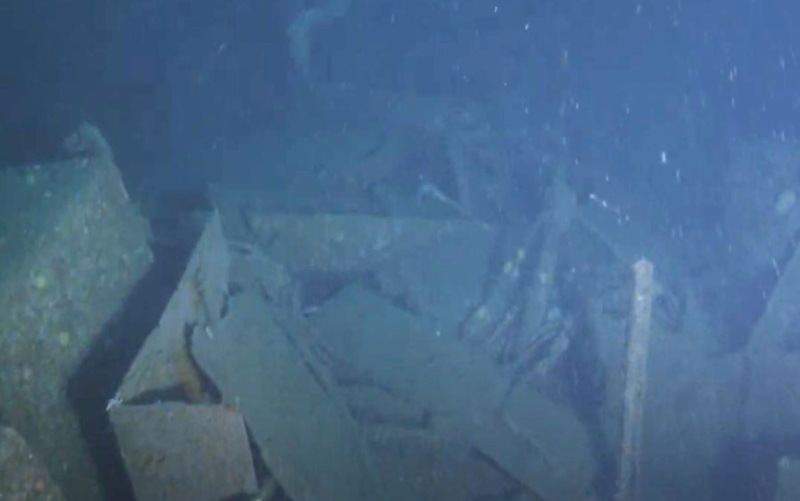
Figure 11: Likely engine compartment space of the shipwreck imaged in 2021. Image courtesy of NOAA/MITech. Download image (jpg, 49 kb).
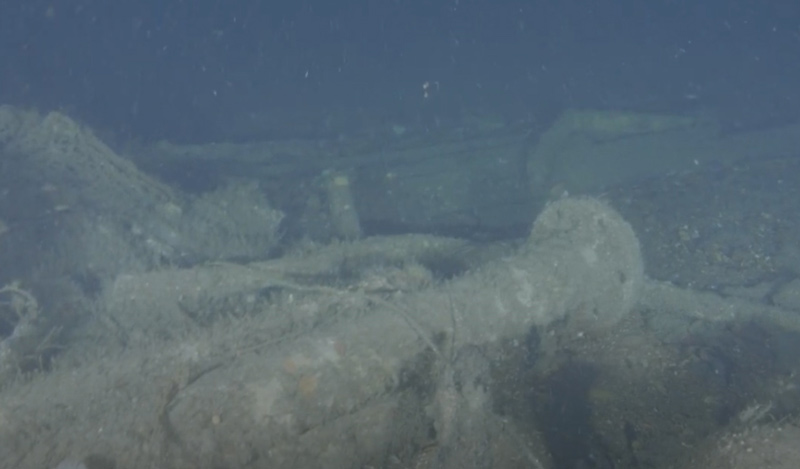
Figure 12: Possible sections of the drive shaft of the shipwreck explored in 2021. Image courtesy of NOAA/MITech. Download image (jpg, 162 kb).
Ballast
As regards to the ballast, the logbook also notes on November 25, 1939, while in port at Newport, Virginia, 45 tons of zinc ballast was loaded onto the ship. The composition of this ballast was also described as “iron” by Robinson (1953) and “lead” by Burroughs (1970), and all sources describe it as “pigs” (or small ingots), but would defer to the logbook as the more definitive source. Burroughs (1970) continues that this ballast was discovered by the steamship company and was sold to pay for the repairs (and a replacement engine). Shortly thereafter, the Canadian owner decided to sell Bear.
During the ROV survey, great attention was given to looking for these “pigs,” but none were found. The vessel had deteriorated to the extent that at least some portion of the bilge where the ballast would have been secured under decking would be exposed, and no ballast was identified anywhere in the wreck site. Given that there was reportedly 45 tons of ballast loaded aboard in 1939, had any still been there, presumably some of it would now be visible.
Again, as speculation, the lack of sufficient ballast, not having either an engine and drive train nor any ballast, one might have expected the Bear, as it was being towed south in 1963, to flex quite a bit, riding so high on the water, opening seams and allowing the sea to pour in.
As mentioned previously, the dimensions of the wreck are reasonably consistent with the length overall and beam of Bear. The ship was 190 feet and 4 inches at waterline, with a beam of 29 feet and 9 inches. Figure 13 shows the rough dimensions of the “unidentified wreck” on the seafloor.
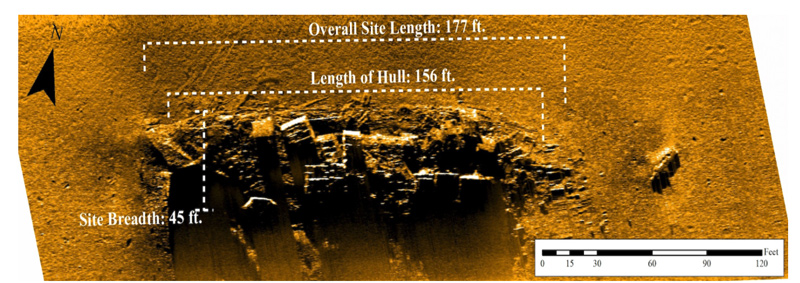
Figure 13: Dimensions of the “unidentified wreck” explored in 2021. Image courtesy of NOAA/ONMS. Download image (jpg, 707 kb).
While the wreck is approximately 13 feet shorter than Bear, it is likely that some of the wreck in the stern area has been dragged away in fishing nets and deposited elsewhere. The width of the site is wider by some 15 feet, as some of the tanks and debris have been also dragged out of the hull and deposited next to the ship. It also appears, in some places, that the sides of the hull have laid down as time passed (and also presumably been disturbed by fishing gear).
The wreck is located around 90 miles due south of Cape Sable, Nova Scotia, based on the position identified by the USCGC Sycamore when the wreck site was located. Various “last known positions” of the ship have been reported during the loss in 1963. The position reported in Bixby (1965) is proximate to the wreck site, while the contemporaneous report from the tow vessel Irving Birch has been reported as approximately 24 miles from the “unidentified wreck.” How accurate these “last known positions” reported by the various aircraft and ships observing the sinking is unknown, but most contemporaneous reports were taken by radio-direction finders. At least one account of the event suggests that the positions reported by Irving Birch may have been somewhat inaccurate (further south than reported), as the Coast Guard aircraft responding to the mayday from both Canada and the United States initially had difficulty locating the site (Bixby 1965). Even with the more accurate GPS capabilities, the positions identified during the 2019 and 2021 expeditions were somewhat different.
Therefore, the “unidentified wreck” was the only potential site identified within the 62 square nautical mile area surveyed in 2019 encompassing nearly all the “high probability targets” identified in the previous research, and proximate to the “last known positions” of Bear when it was lost.
All evidence considered and evaluated, the bow staple configuration, steel sheathing configuration, multiple layers of bow planking, and the stern tube bolt patterns, as well as the location (close to the “last known position” and lack of other wrecks found in the vicinity during the 2019 side scan survey), were highlighted by nearly all reviewers as compelling evidence of the identity of the wreck. Clearly, the observations of both historic and remnants of modern technology with regard to maritime construction was indicative of a ship having had, like Bear, a long history of service and subject to a number of modernizations to meet the changing missions of the ship over time. As well, the heavily constructed and reinforced bow section of the ship, which was the most intact part of the wreck, would have only been present in a ship purpose-built for operating in ice-covered waters of the polar seas.
While no feature identified in the 2021 ROV survey, by itself, would have likely been considered absolutely definitive, taken together, the body of evidence was considered, by the evaluation team, more than sufficient to identify the wreck as Bear with a reasonable degree of certainty.
Therefore, it is the consensus finding of the evaluation team that the site of the “unidentified wreck” is the final resting place of U.S. Revenue Cutter Bear.
Finding the final resting place of a ship, by any measure, that is such an important part of the maritime history and heritage of the United States, and particularly the long and illustrious heritage of the U.S. Coast Guard, was the goal of this collaborative effort, and has been achieved. Through this, the final chapter of the history of Bear can be written. Its loss, in 1963, in this place so far from the locations of its many compelling exploits, achievements, and meritorious service in the polar regions is somewhat out of context, but provides the opportunity to raise awareness of and highlight its important history and significance as part of the rich maritime heritage of the United States. The stories of Bear and the men who served on it during its 89 years of service, often involving bravery, fortitude, commitment, and sacrifice inspire us…stories worth remembering and ensuring this compelling history is honored and not forgotten.
Many individuals and organizations have served an important role in this more than 40-year search for Bear, and their contributions are acknowledged by the partner agencies involved with this final phase of that search. Without these contributions upon which our search was built and advanced, the final resting place of Bear may have never been found.
As to the future, knowing where the wreck of Bear is located provides an opportunity to preserve what remains. Given its location in Canadian waters, whatever preservation of this significant historic site is deemed necessary and appropriate will be another story yet to be written. The Canadian Department of Fisheries and Oceans is evaluating the establishment of a marine protected area which includes this site, and if ultimately designated, while not explicitly recognizing the historic importance of the shipwreck, may help to alleviate any continuing damage to the wreck from mobile fishing gear. Some joint U.S./Canadian recognition of this significant historic site might also be possible, but time will tell whether such a collaborative agreement has the potential to be developed and implemented.
Our part of the story has ended, but Bear lives on…
Published on October 11, 2021